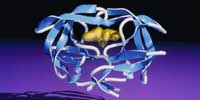

- Elucidating the three-dimensional structure of a target protein is only the very first step in the structure-based design of new inhibitors.
- The next step is to find a lead.
Lead - the term for a compound that binds to the protein of interest.
It often exhibits weak affinity or is too toxic, too unstable or has other shortcomings, yet it forms a starting point to develop molecules with improved pharmacological properties.
- In the pharmaceutical industry an acceptable lead typically has a dissociation constant of 10 mM or better. Thus, only three to four orders of magnitude of affinity have to be gained in the lead optimization process before the low nanomolar range, characteristic for many successful drugs, is reached.
- It is still a major challenge to design de novo leads on the basis of an unliganded protein structure alone.
- In practice, however, the fastest way to arrive at leads might still be to screen
- a corporate database of synthesized or naturally-occurring compounds in solution. Typically, a few hundred thousand compounds can be screened in a couple of months using cocktail screening methods and robotic technology.
- microbial broths and plant extracts; for billions of years nature has been in the business of developing small molecules which attach themselves tightly to essential protein molecules of attacking and competing organisms. Some of these molecules have such an unexpected complexity - take for instance taxol - that it is hard to believe that current drug design procedures would come up with such compounds.
- combinatorial libraries. For example, the phage display method is based on the display of a random sequence peptide on the surface of a phage. The phage library, typically including 106 ~108 different peptides, is mixed with the target protein, which is immobilized on the surface of a plate. Non-binding phages are washed away while the bound ones can be used to decipher the sequence of the peptide bound to the target protein. Alternatively, the affinity screening of synthetic peptide and oligonucleotide libraries offers the possibility of arriving at compounds which are not limited to the naturally-occurring amino acids or nucleotides. Peptoids, linear oligomeric N-substituted glycines, show great promise since they are metabolically stable against proteases.
P C Lyu 11/30/1998